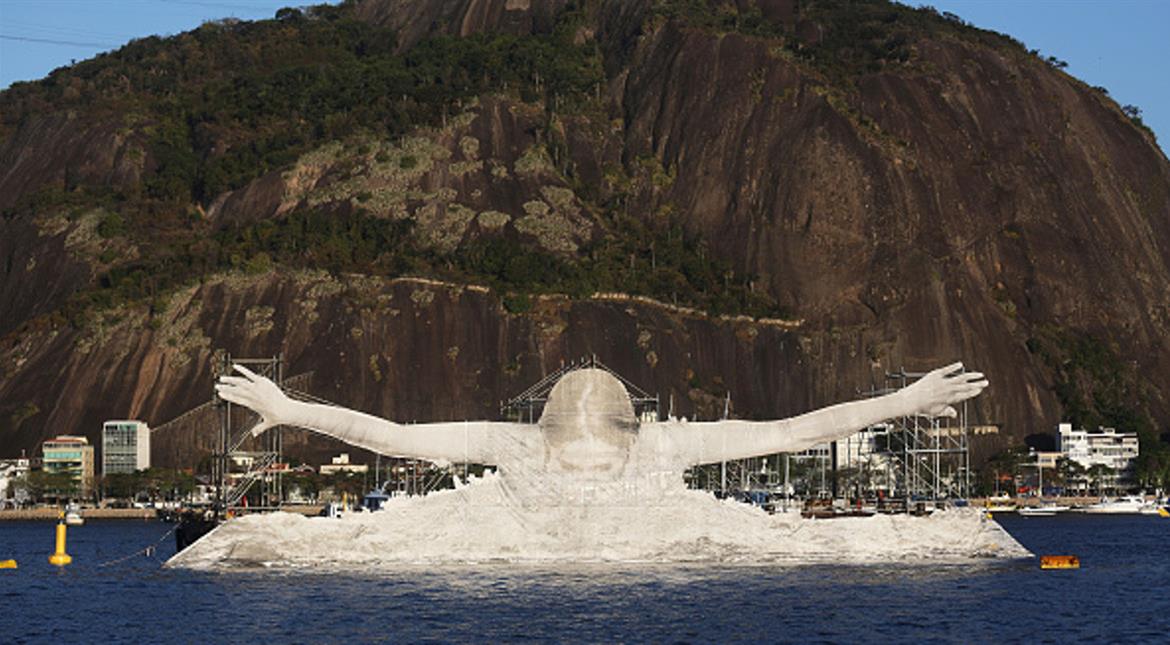He is in Brazil at the invitation of the International Olympic Committee, paying playful tribute to Rio 2016 with superhero-like images that are visible to everyone, whether they have tickets for the Games or not.
"It's like taking the city as a playground... and having sculptures jumping off the buildings,” JR told AFP.
He has set up three such "sculptures" so far, pasting his photographs onto scaffolding at iconic spots around the city.
In the second, near the Olympic park and village, a diver is suspended in motion, arms spread wide and poised to plunge into the Atlantic from the end of a pier.
In the third, a butterfly swimmer rises from the ocean in front of Rio's famous Sugarloaf mountain.
"The idea is to evoke these athletes who train all over the world with the dream of making it to the Olympics. Sometimes they fall just short, like Mohamed (the Sudanese high jumper), who was injured just before coming to Rio," JR said.
The artist has also been touring the city in a giant, rolling photo booth, taking portraits of people he meets and churning them out the side of the vehicle in giant poster format.
He then asks the recipients to plaster the black-and-white photos in public.
He has made a mosaic of them on Olympic Boulevard, in the redeveloped port district at the heart of the Games venues.
- New Olympic sport? -
JR, who keeps his identity secret, knows Rio well. In 2008, he covered the slum walls of the Morro da Providencia favela with black-and-white photographs of the eyes and faces of 30 women, a project he called "Women are Heroes."
A self-described "artiviste," or artist-as-activist, he called it a homage to the women who hold impoverished communities together despite the daily violence they face.
The favela is near Olympic Boulevard, and JR praised the area's transformation.
"That street was just a mess," he said.
"It was pretty dangerous to walk in. Seeing it for the first time (when) people can walk like this and everything is ready and being able to paste there, it's great. It's a great moment."
"Pasting" is how he describes his work. And the Olympian feat of covering a building in photographs makes him and his assistants identify with the hard work and competitive drive of the real Olympians, he said.
"Pasting is a sport to us. When we cover an entire building, we have to go on scaffoldings or paste all day," he said.
"We're trying to make it recognized at the Olympics. It might be a little hard but who knows, one day. Skateboard has just been recognized and gonna be at the next Olympics. So we might get a chance."
-----------------------------------------------------------------------------------------------------------------------------
"It's like taking the city as a playground... and having sculptures jumping off the buildings,” JR told AFP.
He has set up three such "sculptures" so far, pasting his photographs onto scaffolding at iconic spots around the city.
In the second, near the Olympic park and village, a diver is suspended in motion, arms spread wide and poised to plunge into the Atlantic from the end of a pier.
In the third, a butterfly swimmer rises from the ocean in front of Rio's famous Sugarloaf mountain.
"The idea is to evoke these athletes who train all over the world with the dream of making it to the Olympics. Sometimes they fall just short, like Mohamed (the Sudanese high jumper), who was injured just before coming to Rio," JR said.
The artist has also been touring the city in a giant, rolling photo booth, taking portraits of people he meets and churning them out the side of the vehicle in giant poster format.
He then asks the recipients to plaster the black-and-white photos in public.
He has made a mosaic of them on Olympic Boulevard, in the redeveloped port district at the heart of the Games venues.
- New Olympic sport? -
JR, who keeps his identity secret, knows Rio well. In 2008, he covered the slum walls of the Morro da Providencia favela with black-and-white photographs of the eyes and faces of 30 women, a project he called "Women are Heroes."
A self-described "artiviste," or artist-as-activist, he called it a homage to the women who hold impoverished communities together despite the daily violence they face.
The favela is near Olympic Boulevard, and JR praised the area's transformation.
"That street was just a mess," he said.
"It was pretty dangerous to walk in. Seeing it for the first time (when) people can walk like this and everything is ready and being able to paste there, it's great. It's a great moment."
"Pasting" is how he describes his work. And the Olympian feat of covering a building in photographs makes him and his assistants identify with the hard work and competitive drive of the real Olympians, he said.
"Pasting is a sport to us. When we cover an entire building, we have to go on scaffoldings or paste all day," he said.
"We're trying to make it recognized at the Olympics. It might be a little hard but who knows, one day. Skateboard has just been recognized and gonna be at the next Olympics. So we might get a chance."
-----------------------------------------------------------------------------------------------------------------------------









 Home
Home Politics
Politics











